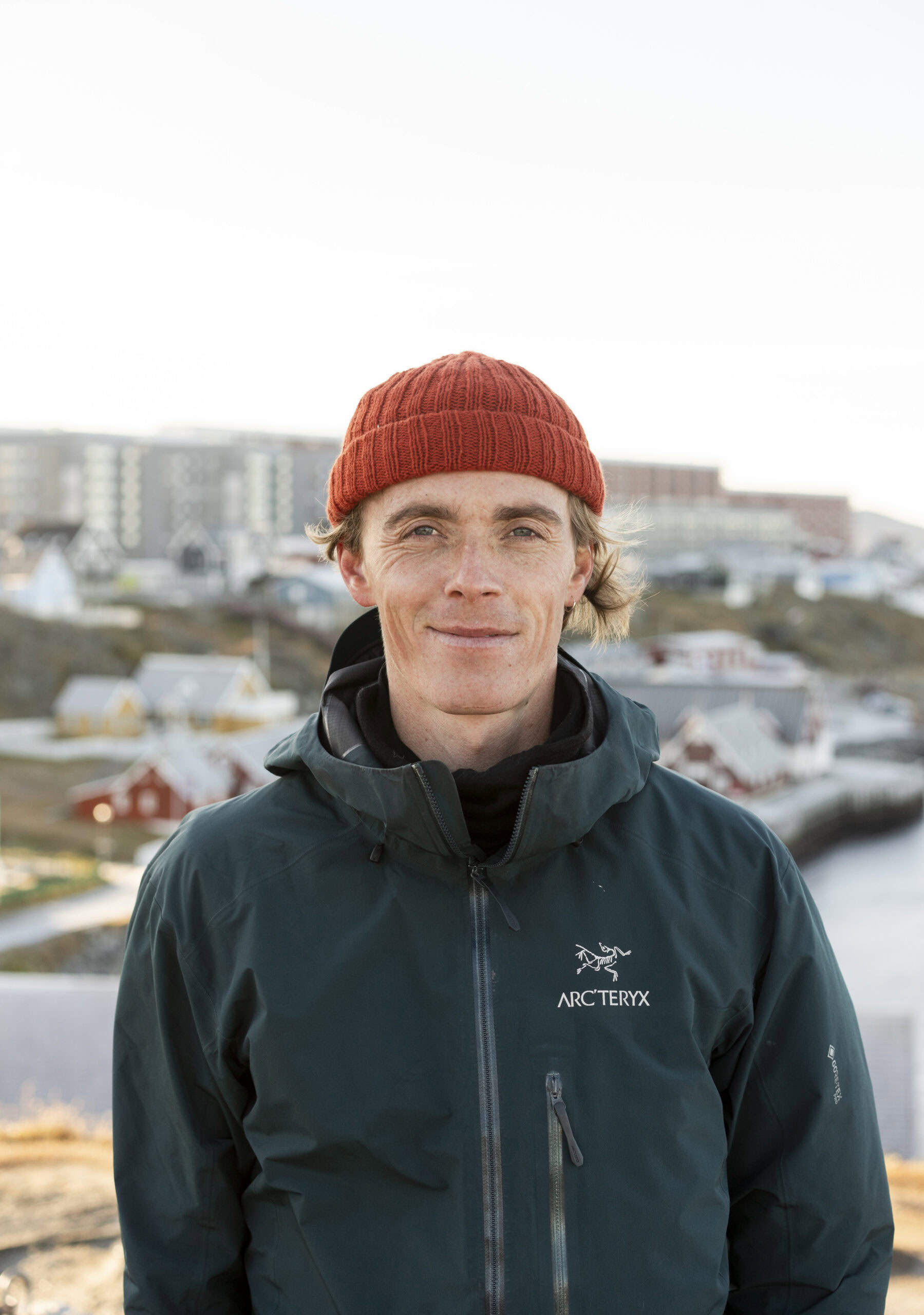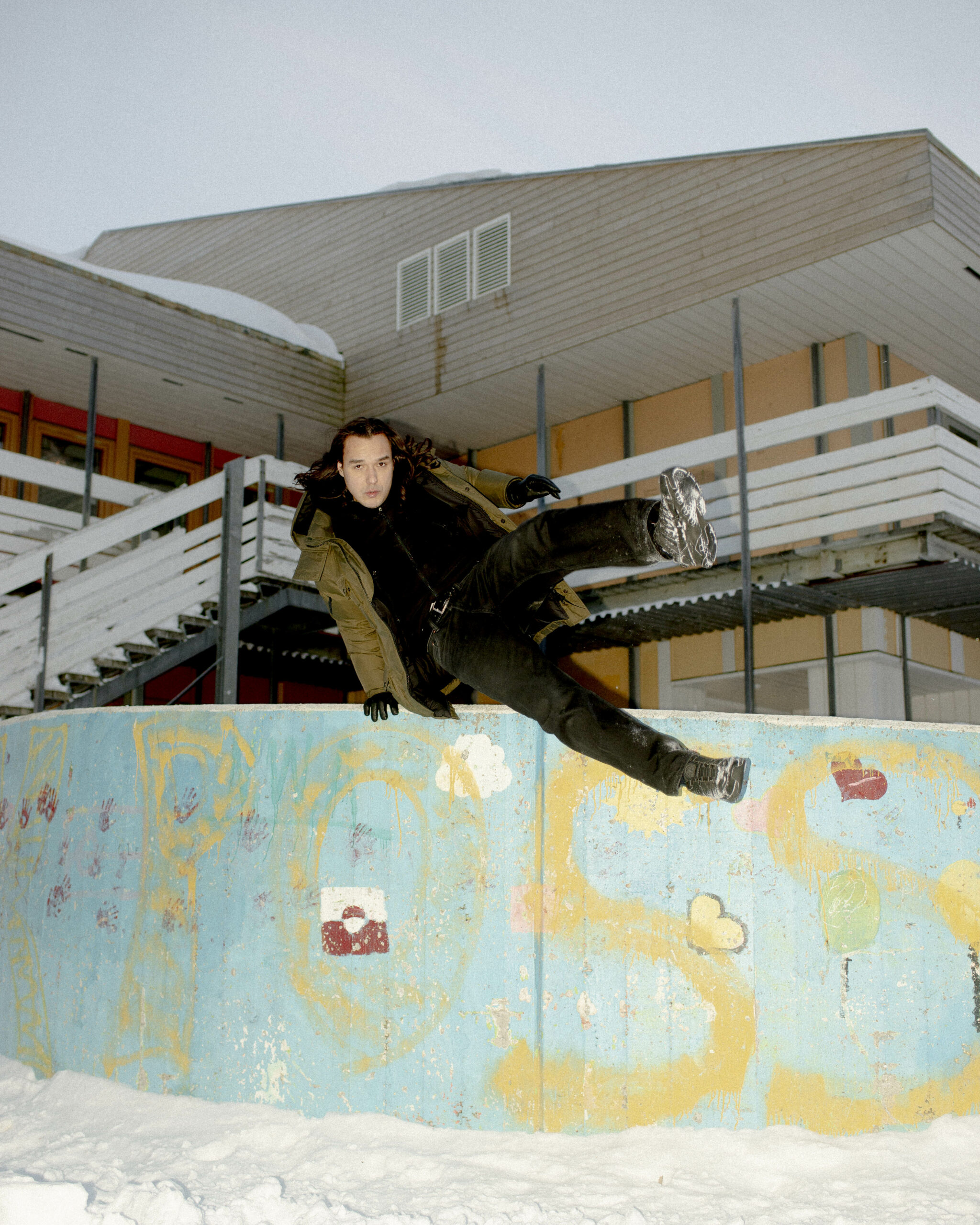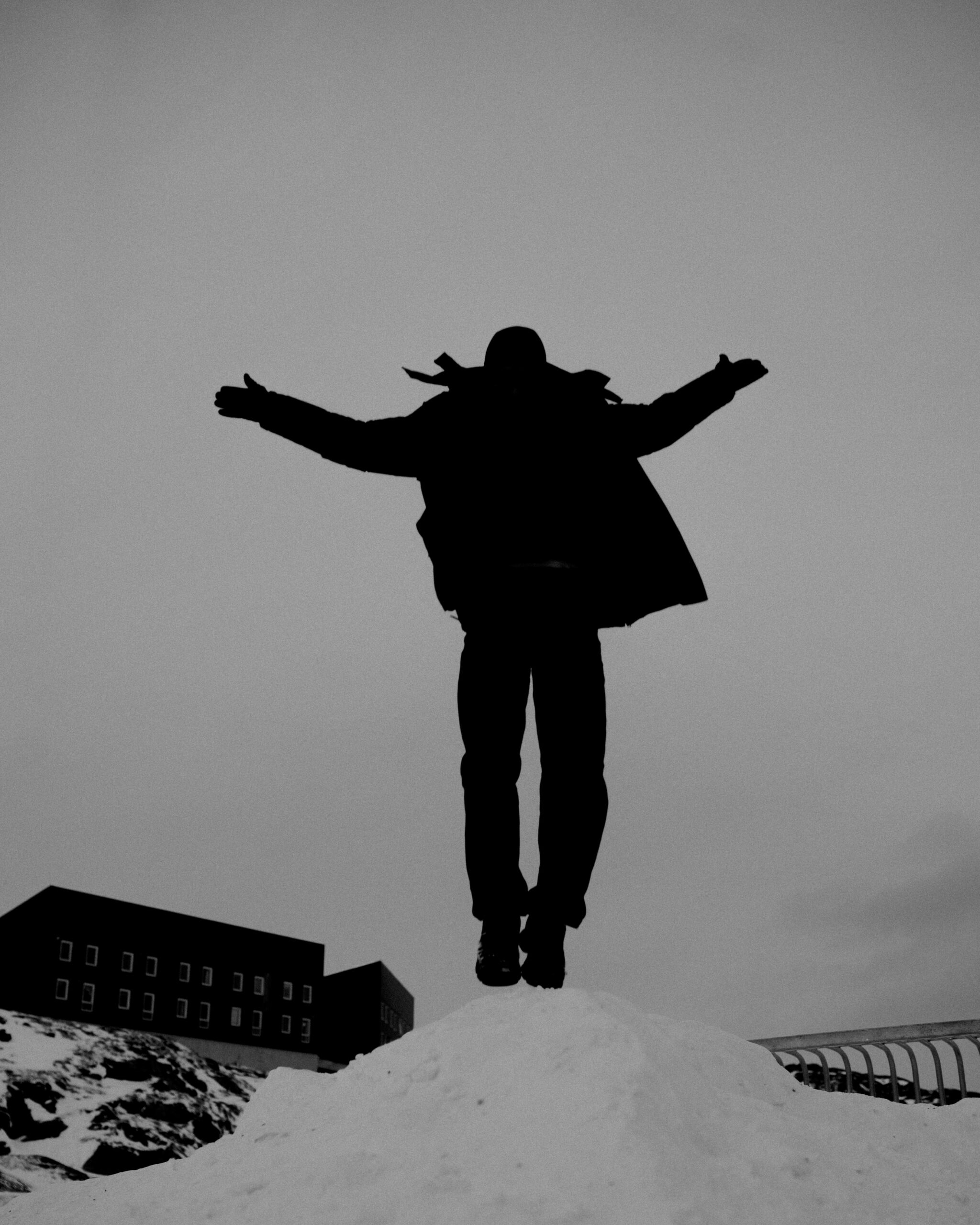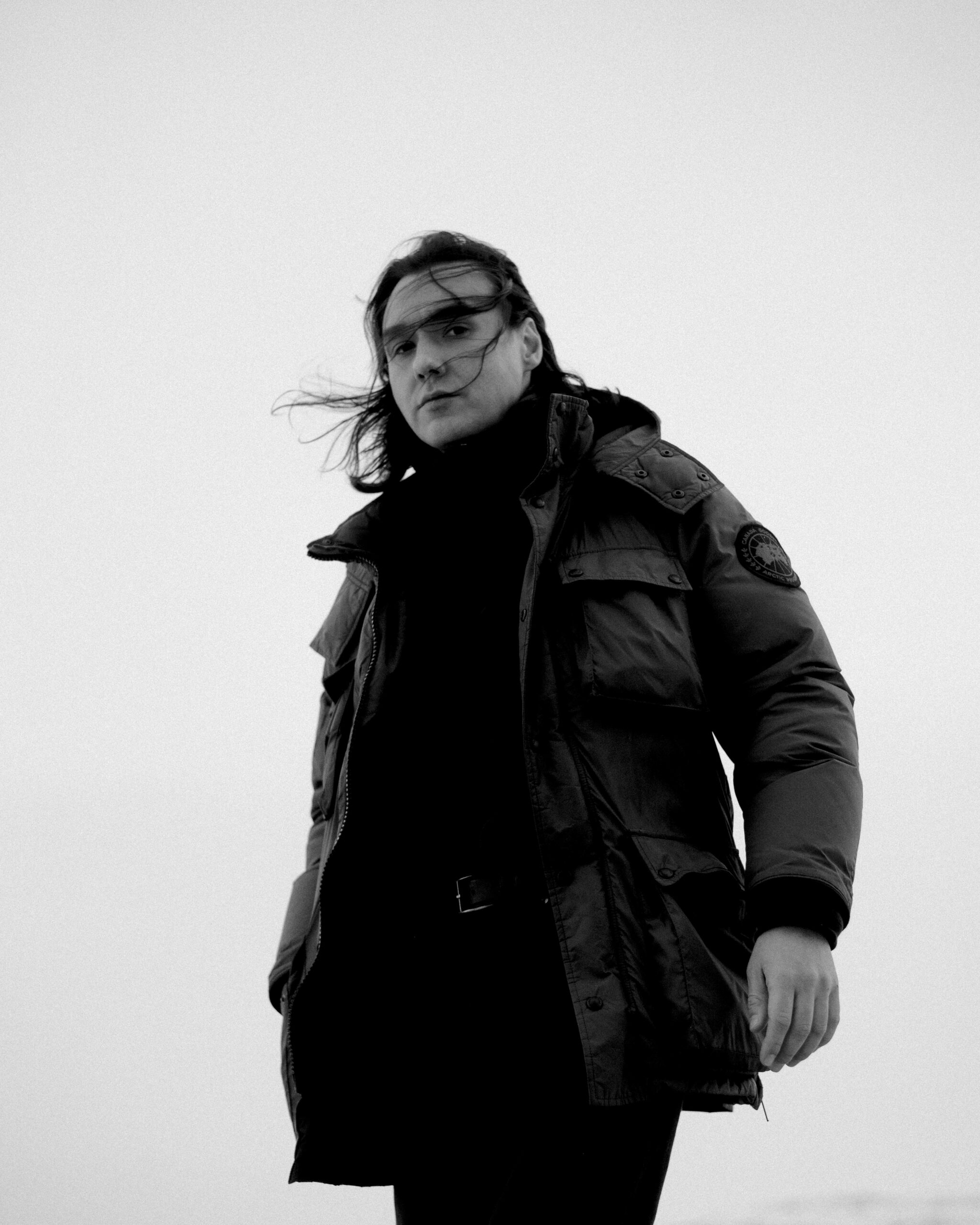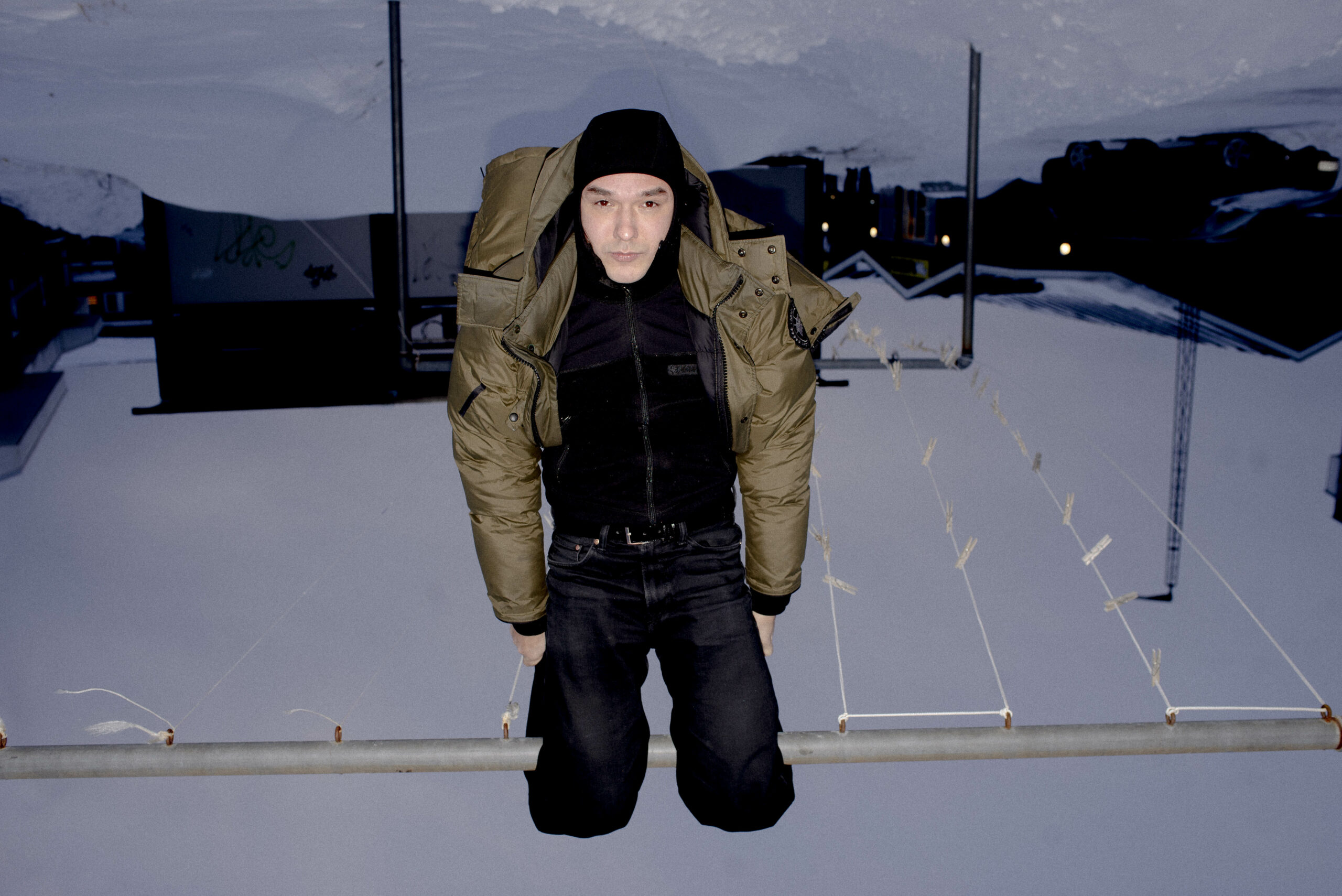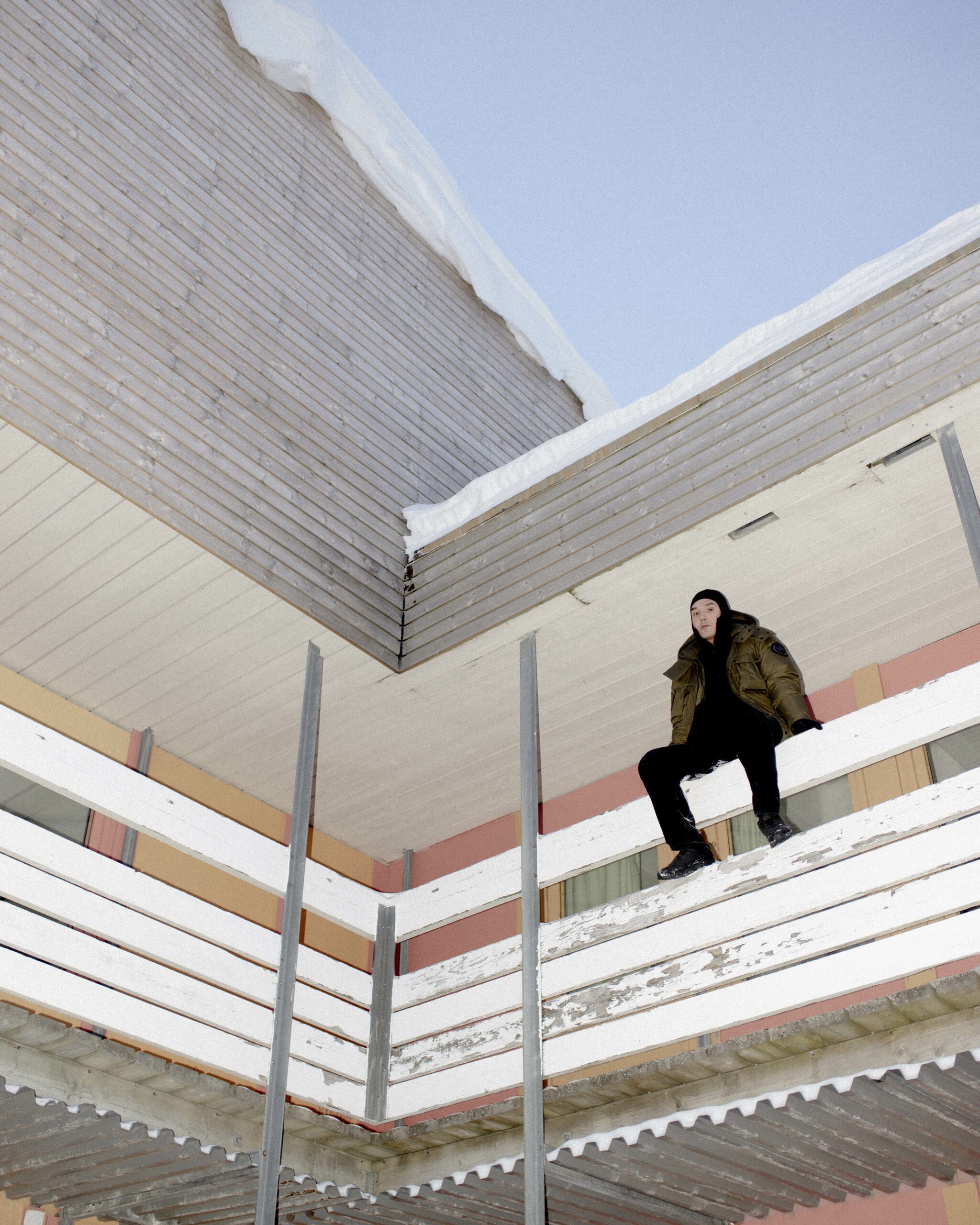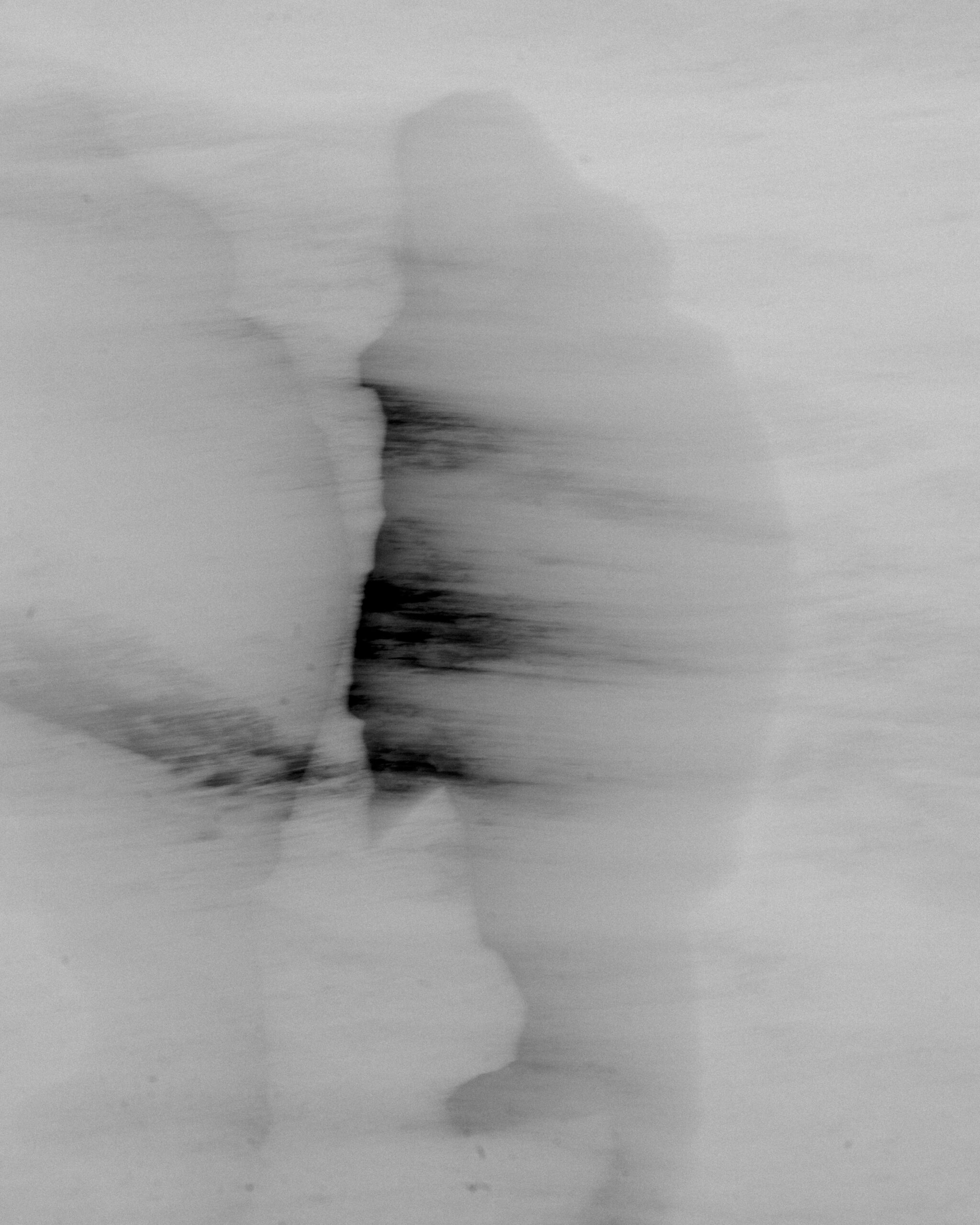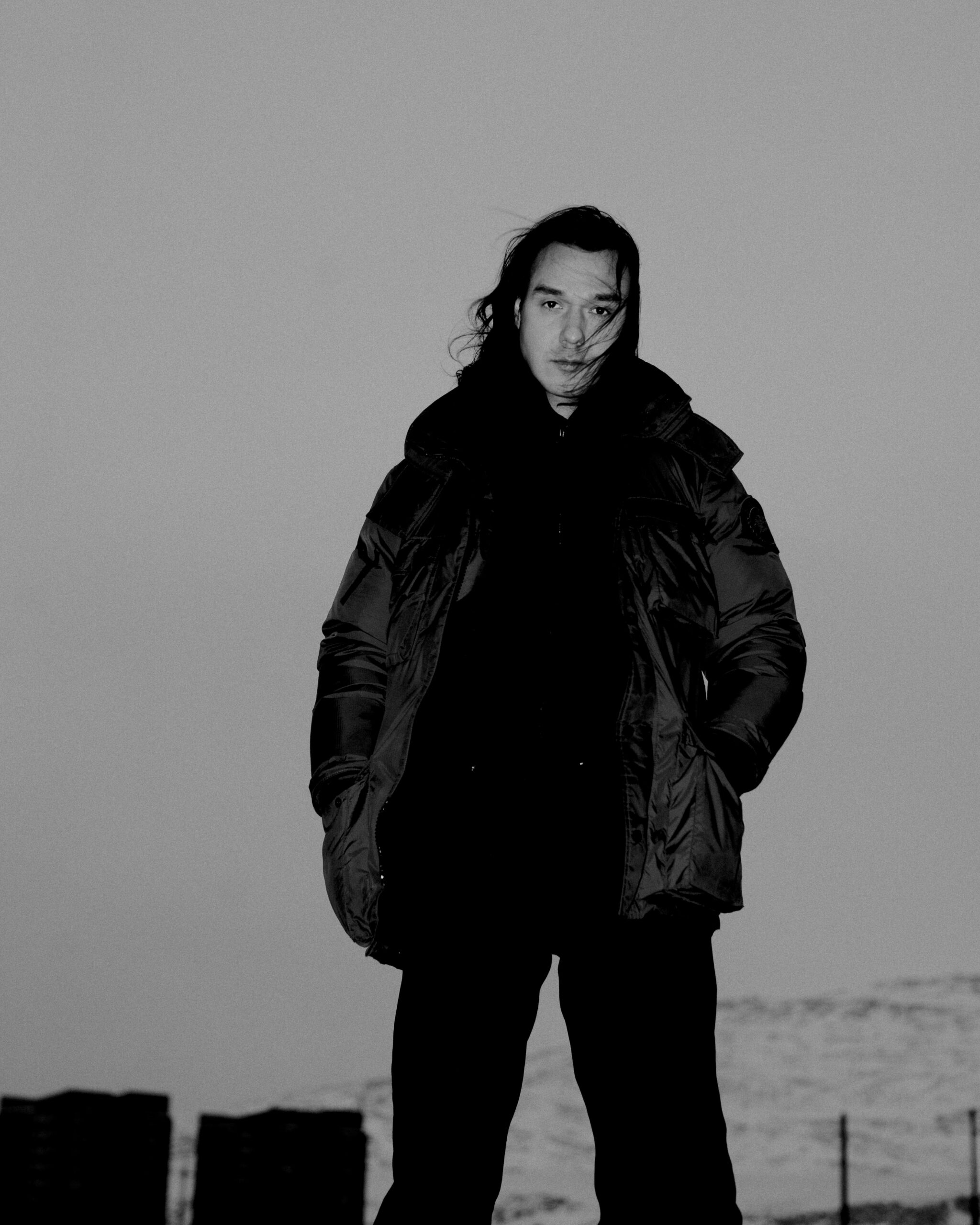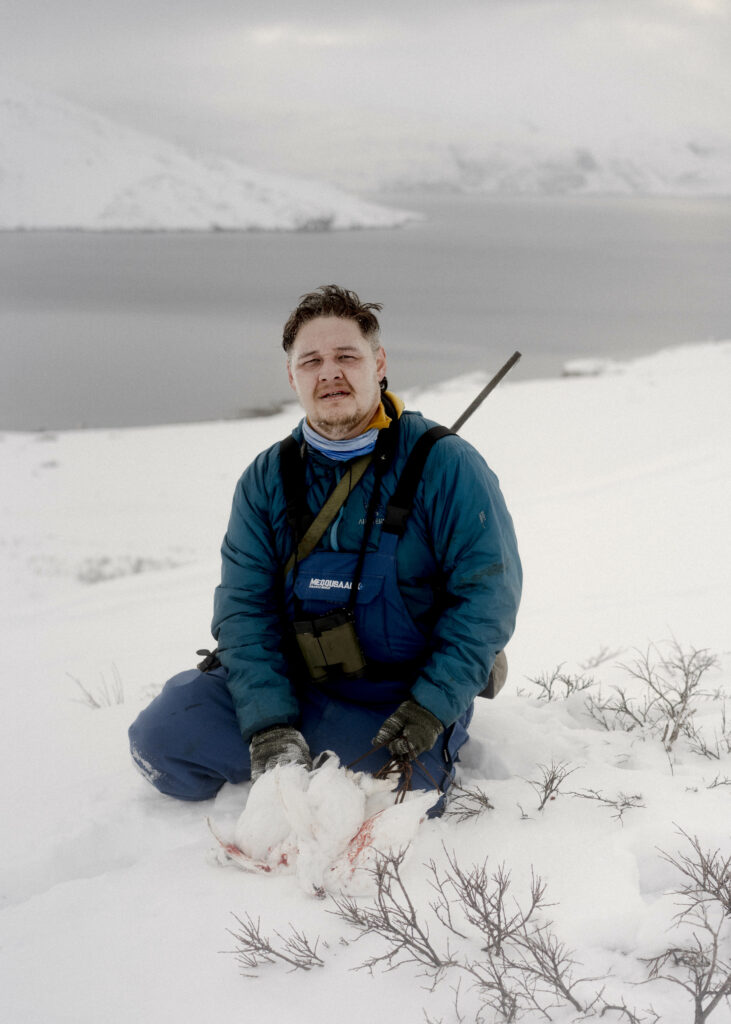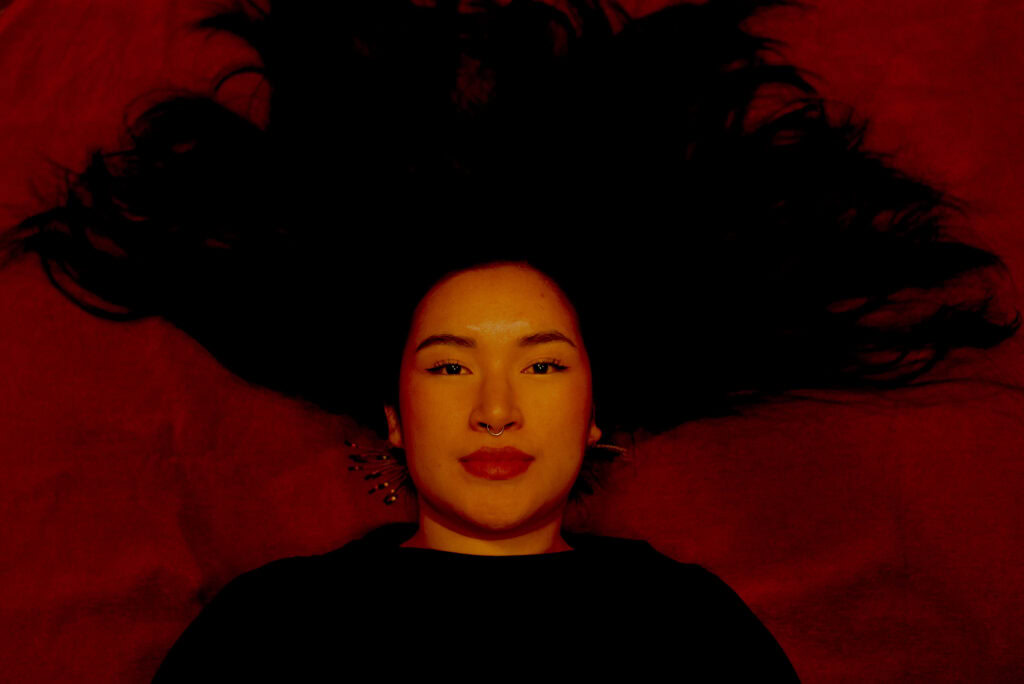Artist Martin Brandt Hansen:
"Faxe Kondi is the most Greenlandic thing I can think of."
Photo – Oscar Scott Carl – Visit Nuuk
Martin Brandt Hansen is an import/export commodity. At least, that’s what he says himself. Rooted in the Nuussuaq suburb of Nuuk, with an address on Frederiksberg, this highly topical artist creates works that depict the Greenland he grew up in and what he sees out the window when he’s home visiting.
Martin Brandt Hansen has agreed to meet at Nuussuaq School. The school where he spent his formative years. It’s no coincidence we meet here. The Nuuk suburb of Nuussuaq plays a significant role in Martin Brandt Hansen’s personal life and in his art.
I’m about to ask about his school days when a raven lands on the railing a few meters in front of us. That’s where our conversation begins:
Martin: “Look at that raven there. Damn!”
Oscar: “Do you include ravens in your art?”
Martin: “Yes. They have always been part of my view and existence. They are somewhat of a national symbol with a long background in Greenlandic prehistory and mythology. They’re a bit unpredictable – you never really know what they want!”
Oscar: “Is that like you?”
Martin: “Well, you’d want to be like a raven in your next life. They’re just cool.”
A Nostalgia
We continue up the long staircase in front of the school, which Martin Brandt Hansen flew up and down countless times in his childhood. At the top, we turn right and make a stop 100 meters later in front of a red apartment complex. One of Martin Brandt Hansen’s childhood homes. His mother’s apartment.
Oscar: “So, you sat there in the red apartment as a child, looking out?”
Martin: “I could see directly down to my dad’s apartment. I lived two days with my mom and then two days with my dad.”
The area where Martin sat and gazed out as a child, Nuussuaq, is part of his art. The postal code 3905 is tagged on his modern interpretations of terracotta vases, and generally, he doesn’t hide the fact that Nuussuaq as a place and concept is essential to him. Past and present.
Oscar: “You use Nuussuaq in your art – what role does the area play for you?”
Martin: “As a child, it was extremely luxurious to grow up in such an open and quiet place. Especially in the 1990s, where I was fed with all sorts of things: Nintendo 64, MTV, heavy metal, and cartoons. It was an era, a golden age in history as a creative and curious person.”
Oscar: “Why is the district of Nuussuaq such an active and concrete part of your art?”
Martin: “Well, I need something to build my art on, you see. I can’t just make something without filling it with content. So the content must be something that means something to me. At the same time, I also want to create something that’s a bit different. I try to create something original that is also contemporary. So it’s not all about seals, ulus, and polar bears.”
”When I've been away from Greenland for a long time, I feel completely withered. I feel completely dry. So I need some juice. I need to go back.
Martin Brandt Hansen
What is Greenlandic?
We continue our walk. Turning our backs to the cold northern wind, which is blowing hard this early January afternoon. I’m curious about the idea that the content, or the art, as we’ve chosen to call it, must mean something to him. That the content must be contemporary. Because what is contemporary, and when is it no longer?
Martin: ” I want to create something with a bit of Greenlandic in it. But how can you define what is Greenlandic? Even today, when you classify things as Greenlandic, it’s always a kayak or a drum, and there are so many other things that are Greenlandic. People live in modern homes. It’s an infrastructural society with the whole package.”
Oscar: “Do you have a particular piece that you think symbolizes that?”
Martin: “Lately, I’ve been fixated on the Faxe Kondi bottle from Nuuk Imeq (a local soda producer). That’s something that is the most Greenlandic thing ever. We should almost have it as a coat of arms. And it’s also a unit of measure. The funny thing is, the bottle has that special design with the hard plastic. It’s extra strong now because Nuuk Imeq is closed.”
I had actually scheduled a meeting with Martin Brandt Hansen the day before we were standing here in the windy Nuussuaq with the neck warmer pulled up around our necks and the hood over our heads. A few hours before our appointment, however, Martin Brandt Hansen postponed. He was busy buying 15 crates of Faxe Kondi, he wrote. For an art project. I ask a bit about yesterday’s purchase of Faxe Kondi. Martin Brandt Hansen jokes that nobody probably expected that some of the grant money he just received would be used for soda, but what do you do in the name of art? And why exactly 15 crates of Faxe Kondi?
Martin explains: “Sometimes I think of my practice as a small museum. I got them with the idea that you should be able to remember what they were like. Many people believe that they tasted much better than the Danish Faxe Kondi. It was fresh Greenlandic water that was used. Nowadays, I prefer Coke actually, but I totally agree that the Coke Nuuk Imeq made was more lively.”
We take shelter behind a small bicycle shed. I’m curious about something I’ve heard him say in a video on Youtube in connection with a previous exhibition.
Oscar: “You’ve said you’d rather ask questions in your art than answer them. What questions do you ask?”
Martin laughs. He looks at me before he answers. “That’s a good question! It’s such a perfect A+ question. What questions do I ask, haha!”
He continues: “When I ask myself questions, it’s like: How Greenlandic is an object? How much can one allow oneself to say that an object is Greenlandic? Or vice versa? Where is the dividing line between something being Greenlandic and when it’s not? I find that extremely interesting because there isn’t really an answer to it. There aren’t any experts who can say: Because the bottle is produced here in Nuuk, but it’s a German design then its….”
Martin explains before continuing:
“I had found a cruise ship that had once docked in Nuuk, and I could see it from my view here in Nuuk. So I exhibit it because it’s normal for me to see it. For other people, it surprises them that a Greenlander is exhibiting a cruise ship because they say: That’s not Greenlandic at all. If it sailed around in the Caribbean, it’s not Greenlandic, but it’s something I’ve seen out my window.”
Uummat (heart)
Martin Brandt Hansen has a Master of Arts from the Royal Danish Academy of Fine Arts. He is a contemporary artist, dealing with the modern, the contemporary, as we’ve already established. Graduating in 2022 and with a successful solo exhibition at Andersen’s gallery in Copenhagen last year. All works from the exhibition were subsequently sold and are part of the prestigious museum Arken’s new collection.
In the middle of the exhibition space there was a Honda outboard motor. Martin Brandt Hansen explains:
“I exhibited a large Honda motor in the middle of the room. It’s one-to-one instead of exhibiting a kayak. People don’t use kayaks today to get their food; they go to the supermarket. Instead, that Honda motor is used from north to south. All fishermen/hunters out in the settlements use that. The piece is called “Uummat,” which means heart.”
I don’t know if Martin Brandt Hansen himself would say he likes to provoke. I actually doubt it after spending a few hours in his company. He strikes me as a cheerful and also quite mild person. But he’s not afraid to create what he wants. And sometimes it can end up being provocative. You see that in his art, and you also saw that when he in his early twenties was part of the hugely successful and also criticized satire program Labrador’ Kangian‘, which made fun of everything and everyone and set viewer records on KNR, Greenland’s largest TV channel.
The most recent line on his resume says recipient of a grant, as in December he received an honorary grant of 100,000 Danish kroner from the Aage and Yelva Nimbs Foundation. In the explanation from the foundation, it read, among other things:
“Martin Brandt Hansen’s works captivate the juxtaposition of traditional Greenlandic iconography with Western imported culture and industry. With humor, bite, and edge, Brandt Hansen explores and challenges the objects of Greenlandic culture as well as the dominant Western narrative.”
Nuuk is my juice, Copenhagen my sea
Okay. Martin Brandt Hansen’s art is described as “the juxtaposition of traditional Greenlandic iconography with Western imported culture and industry.” But what does that mean in ordinary words? Our walk continues in the childhood neighborhood, and I ask about one of the juxtapositions in his personal life: Address on Frederiksberg in Copenhagen but rooted in Nuuk.
Oscar: “You actually operate on two stages. Nuuk and Copenhagen. What’s that like?”
Martin: “I become a bit schizophrenic. Import/export-like in the soul, huh? It’s a strange feeling of having two homes.”
I can’t help but think that his life as a child in Nuussuaq with two days at his moms place followed by two days at his dad in some way continues into his adult life.
Martin continues: “Practically, I can work both places, but I feel like I have to come home to the juice here (in Nuuk). When I’ve been away from Greenland for a long time, I feel completely withered. I feel completely dry. So I need some juice. I need to go back. I need to go out and talk to some people. When I have to go back to Copenhagen, it’s like going out to sea again, like the sailor has to go out on the ship again. Then I have to go to work.”
”"There's nothing inherently wrong with sleds, polar bears, or sunsets. But Greenlandic visual art shouldn't predominantly be an exotic fetishistic product targeted at the tourism industry. It should reflect the present!"
Martin Brandt Hansen
I’ve just bought a ceramic oven
We pass by the local discount chain Akiki. I have an idea that we should take some portrait photos inside the store. An idea that I haven’t told Martin Brandt Hansen about yet, and first, I must ask the obligatory question one asks a rising young artist:
Oscar: “So, what now? Going forward? What’s next for you?”
We both laugh. Perhaps at the degree of cliché in the question, perhaps because of the fact it can be difficult to answer in the constantly changing art world that Martin Brandt Hansen is part of.
Martin: “I’ve just bought a ceramic oven. Now I need to buy clay, glaze, and tools. And then I have to pay the electricity bill. I’m going to delve into design again. I’ve missed that a lot, and it’s possible again now with the new oven.”
He continues: “I have this urge to exhibit more. I’ve got a taste for it now. I just have to go all in with ceramics, and they also sell like hotcakes.”
After a trip to Akiki, our tour ends back at Nuussuaq School, where we started. My fingers are cold from holding the microphone. We talk a little about where and which pictures should be taken for the article. Martin walks up the fire escape stairs at the school and ends up on the second floor. He sits on the railing and gazes out over the schoolyard. Exactly as I imagine he did when he was 10 years old.
So what have we learned? Neither Martin nor his art can be put into boxes. On the contrary, boxes are opened to new understandings of what is actually Greenlandic. Questions are raised. Traditional Greenlandic mythology merges with contemporary window-gazing in central Nuuk.
Martin Brandt Hansen has one last important point:
“There’s nothing inherently wrong with sleds, polar bears, or sunsets. But Greenlandic visual art shouldn’t predominantly be an exotic fetishistic product targeted at the tourism industry. It should reflect the present!”
